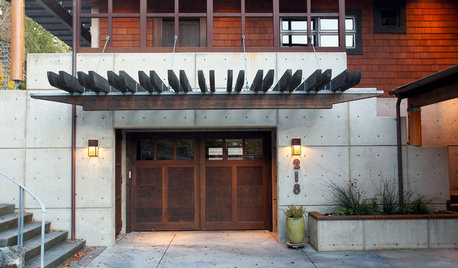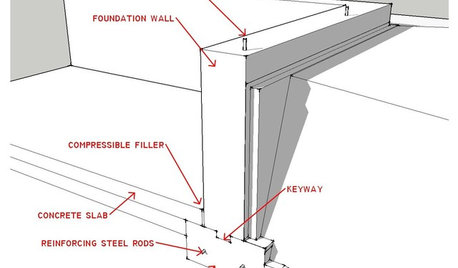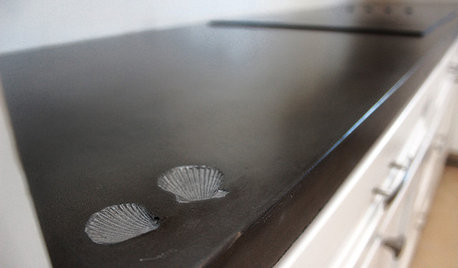how long should foundation concrete cure?
One builder I am talking to says he pours the footings, lets them cure for 28 days and then pours the basement walls. Is this normal, or is it kind of like wearing a belt *and* suspenders?
Comments (49)
cedar32
14 years agofor our foundation, the footings were poured one day and the walls poured the next day. I think that is pretty standard. It is true that concrete takes 28 days to fully cure.
kudzu9
14 years agoThat does sound like "belt and suspenders," but in this case, it's a good thing. If it were me, and I had the time to wait, I'd do it. If you look at curing time for concrete, it's a very long curve. While it gains most of its strength in the first couple of days, it continues to pick up strength as time goes on. If you look at the link below, you can see how it takes a week to get to about 60% of maximum strength and about a month to get to about 100%. While you don't need to wait until it gets to 100% before you pour again, obviously you will have a stronger base, with less chance of cracking, if you wait.
In addition, I don't know what your weather is like right now, but colder temperatures slow down the speed with which concrete cures. I think you've got a responsible concrete guy, who wants to do a good job, and I'd pay attention to him.
Here is a link that might be useful: Concrete curing curve
Related Professionals
Panama City Beach Architects & Building Designers · Angleton Home Builders · Big Bear City Home Builders · Vista Park Home Builders · Athens General Contractors · Canandaigua General Contractors · Chicago Ridge General Contractors · Country Club Hills General Contractors · Highland City General Contractors · Kailua Kona General Contractors · Millville General Contractors · New Bern General Contractors · Palestine General Contractors · Seguin General Contractors · Walnut Park General Contractorsbuckheadhillbilly
Original Author14 years agoThanks, kudzu! That's great information. We're actually not breaking ground until Spring, but this was something that came up that set this builder apart and I wanted to find out more. Sounds like I need to let it cure and try to be patient.
fish7577
14 years agoSounds like your builder is either overly cautious, or he wants a good excuse to start one job while he still needs to finish another. The concrete may not be fully cured, but it doesn't need to be to withstand the weight that will be on it for the first couple weeks. The weight of the poured walls is not going to stress your footer, especially if it's a day or two later. If you're using 4000 psi footer mix, then even having a fraction of that strength the next day will withstand your foundation walls with no problem.
When we were planning for steel pan to support a porch deck, then steel was engineered to support wet concrete at 150 pounds per cubic foot.
If you figure 150 pounds per cubic foot of concrete, you'll only have a little over a pound of weight per square inch for each 1 foot of height (150# divided by 144 sq inches). A ten foot high wall will only put 11 pounds of weight per square inch.
It seems like its the overall weight of the finished house that requires more support. Unless you're on extreme home makeover, I don't think you'll be anywhere close to any weight issues for weeks (and likely months).sierraeast
14 years agoBonding is better when the footers concrete is "green" when the walls are formed and poured. The contact between the footers and walls will adhere better when the walls are poured after a few days. There's really no advantage in waiting 28 days for the footers to "cure". The curing process with concrete goes on for years to the point where, when fully cured, it starts on the road to breaking down. That takes a long time. Concrete mixed and poured out right can last centuries! One of the biggest concerns is what is underneath the concrete concerning soils type, compaction, and drainage. The other concern is that the proper rebar/mesh installs are the correct sizing and installed properly for the project,( whats in with the concrete).
macv
14 years agoSomething is wrong with the schedule.
The footing should cure 2 to 3 days before the wall is placed on it depending on the weather unless you are building a multi-story apartment building or there are unusual gaps and/or steps in the footing or spread footings for point loads or the building is constructed of load bearing prefabricated walls.
I can think of no condition that would require waiting 28 days.
sierraeast
14 years agoOut here in "slab world", there's a builder who typically has multiple projects going on and in the summer months, berms the perimeter of the slab after the pour and keeps a thin amount of water on it for around three weeks in order to slow the cure and not let it dry out too fast in our extreme hot/dry climate in the desert. He's the only one in our area that does that, everyone else has the framing going on within a few days of the pour.
buckheadhillbilly
Original Author14 years agoThank you all for your input. I'm not sure what I'll do about this. I really like this builder and his houses are extremely well built. He's been building for 40 years including lots of mountain homes hanging off of the edge of a ridge. I will be building my first ever house. If I choose him, I may just let him do it his way. He actually doesn't have much work right now, so he's not suggesting this as a stalling tactic. He got his start building lake dams and such, so he is a stickler for details -- you really don't want your work to fail when you're building dams! The way I see it, it might not help but it couldn't hurt.
kudzu9
14 years agosierraeast-
I know what you are saying about bonding, which is why I always make sure my cured concrete is adequately dampened when I make a second pour. But when you are talking about walls poured on top of footers, I'm of the opinion that what matters most is having plenty of the right size rebar embedded and sticking out of the first pour so that there is a strong mechanical linkage. If you have that, then I think that the benefit of any improved bonding that may occur by pouring on top of green concrete is in the noise level. I have a neighbor who runs a large commercial construction company and they pour quickly when they have to, but wait longer when they can.I think this is an issue on which reasonable people can disagree. I prefer my first pour to cure and strengthen longer than a couple of days. That's just my opinion.
sierraeast
14 years agoHi Kudzu, I agree 100% with you on that and that is why my last statement on that post was: "The other concern is that the proper rebar/mesh installs are the correct sizing and installed properly for the project,( whats in with the concrete)".
We were always taught at least a week, I just simply stated that 28 days was extensive or extreme period before the walls pour. I also agree with hillbilly that he should go with the builders m.o. on this as this builder sounds like he knows what he's doing and will be on top of it.
buckheadhillbilly
Original Author14 years agoYou know, I just had a flashback to the '80s when the IBM Tower was being built in Midtown Atlanta. The big news was that the elevator shaft was being done in a continuous pour. They had concrete trucks and a pumper going around the clock.
Why was that? When you are bulding concrete up vertically, do you want it all to be about the same "age"?
Sorry to sidetrack the conversation, but this is such a good discussion and the question popped into my mind.
sierraeast
14 years agoHi Buckhead, because it's a continous pour, it gets poured out non-stop. You can relate it to your build. Your footers are poured out, then the walls will be poured out as a "continous pour", only on a much more minor scale than the awesome elevator shaft project! It's all relative. I would have liked to see the method they used to vibrate the crete on that project. That alone would have no doubt been impressive.
macv
14 years agoA continuous pour avoids "cold" joints in the concrete (where the concrete does not bond). Why that was important is hard to say without knowing the design but I would guess that the lateral force (wind and earthquake) resistance of the structure relied primarily on the strength of the elevator shafts.
There is nothing magic about 28 days. It's just a standard time period used for the testing of concrete samples to determine if they have met the design specification.
manhattan42
14 years ago"One builder I am talking to says he pours the footings, lets them cure for 28 days and then pours the basement walls. Is this normal, or is it kind of like wearing a belt *and* suspenders?"
Choose THIS builder because he is absolutely right!
He has the EXPERIENCE to know this is TRUE and the PATIENCE to give you a quality end product because of his experience and patience.
Concrete is NEVER considered 'cured' until at least 28 days after it has been poured.
Building Codes nor Standard Engineering Practice consider concrete or poured masonry products to be 'cured' until at least 28 days after pouring.
While it may be 'common' to construct block or poured foundation walls on concrete footings that have been allowed to sit for 2-3 days, NO respectable builder...NO respectable architect...NO respectable engineer and NO respectable designer who knew what he was doing would EVER recommend ANY concrete product to be built upon or be considered 'cured' after only 2-3 days... regardless of mix...regardless of weather...regardless of circumstance.
Only someone who was completely INEXPERIENCED and had no actual expeience as a builder or mason would suggest otherwise or would suggest something so silly....
28 days minimum for curing.
Period.
worthy
14 years agoThe Canadian Standards Association recommends a minimum curing time of three days, less if 40% of design strength can be reached earlier.
FWIW, I usually end up with 10 days between footing pour and walls. After three days, the footing boards are stripped. Then the municipal building inspector must okay them. Finally, the forms are brought in and set up and it's ready for pouring. Block walls go a bit faster.
iamsum
14 years agoOn our house we had the footings/foundation poured and almost 2 days later they started prepping the subfloor. They did this and setup the floor joist and then we waited about 2 weeks for plumbers to run their lines and get floor insulation in. Subfloor went in and we started framing probably 3-4 weeks after we removed the forms.
brickeyee
14 years agoResidential work does not load concrete work very heavily in most cases.
A common exception is slab on less stable earth.
Bond beams, post tensioning, and other techniques are then used to create a monolithic slab that will act as a single piece and uniformly spread loads.Most of the size is for load spreading on the ground, and the ability to neglect point loads introduced by the house framing.
By making the foundation stronger than needed, the load concentration produced by large openings in the framing is ignored.Even basement walls are not that heavily loaded by backfill. The tipping problems that occur are from a lack of lateral resistance before the floor joists are installed.
I have seen basement walls fail, but they had enough curing to fall over as a unit after a fracture near the middle.
Adding floor joists before any back-filling has been SOP for many years, yet occasionally seems to be ignored.3-4 days of curing is usually more than enough to continue framing.
jeff8407
14 years agoI am a structural engineer and I have to chime in...Pouring the walls the next day is absolutely fine. Concrete cures depending on the mix, ambient temperature, water content... As long as the cure rate shows that the concrete is strong enough to handle the load the next day it will be fine. In fact, applying force or mass--i.e. stressing concrete--can also dramatically increase its strength. BTW concrete never actually completely cures--40 year-old concrete is still getting stronger....
worthy
14 years agoAdding floor joists before any back-filling has been SOP for many years, yet occasionally seems to be ignored.
I'm always amazed. (And silently smug when I see a collapse.) I used to delay backfilling till the roof was framed and sheathed. But then I have persistent nightmares that the homes I build will collapse in on themselves without warning like something out of Poltergeist.
macv
14 years ago"Concrete is NEVER considered 'cured' until at least 28 days after it has been poured."
Concrete does not actually harden by "curing" nor is there any point in time when concrete would be considered "cured."
Concrete naturally hardens over time by "hydration", the chemical reaction between portland cement and water in the concrete mix. "Curing" describes a procedure that an installer may choose to use to insure more complete hydration of the portland cement (and therefore greater concrete strength) by controlling moisture loss during the critical early part of the hydration process (ie 3 to 7 days). In the case of a residential footing curing might consist of simply covering the concrete for 3 days. In any case the curing procedure would not normally continue beyond 5 or 7 days depending on the temperature of the air.
28 days has nothing to do with the maximum strength of concrete; it's just an arbitrary time chosen because the strength gained after that time period is normally not important from a design point of view and there has to be a standard measuring point in order to allow enforceable specifications and uniform strength testing. As long as moisture and a favorable temperature are present for hydration of the cement, the strength of new concrete continues to increase long after the early curing phase and the 28 day mark. Since the actual strength of the concrete in a residential footing is not particularly critical, testing is not required so the 28 day mark has no practical relevance in the field. In fact, if the concrete hasn't reached the minimum strength required by code in 7 days, it's unlikely to get there.
The IRC requires a concrete footing to have a minimum compression strength of 2,500 psi which is a low value and easy to achieve (most specifications would be higher). If a concrete footing is reasonably protected for 3 days, it should have reached 70% of the minimum required strength and it should reach 100% by the 5th day.
What we're really discussing here is whether the load capacity of the footing needs to exceed the loading from the foundation wall by 200% before it is considered OK to pour the wall, or should it exceed it by over 300%.
Delaying the foundation work for 3 1/2 weeks would be unprofessional IMHO.
brickeyee
14 years ago"28 days has nothing to do with the maximum strength of concrete; it's just an arbitrary time chosen because the strength gained after that time period is normally not important from a design point of view and there has to be a standard measuring point in order to allow enforceable specifications and uniform strength testing."
28 days was chosen since it is the 90% strength point of long term strength for almost all concrete mixes.
It is far from arbitrary.
macv
14 years agoI meant to say: "by a factor of 200" vs "by a factor of 300".
The hypothetical designer described earlier "who knew what he was doing" would supposedly refuse to allow an 8 PSI load to be placed on a footing with a 3-day load capacity of at least 17,000 PSI and possibly 2,500 PSI*. I won't characterize that earlier claim since it speaks for itself.
* Since typical modern specifications call for 3,500 PSI concrete, normally the strength after 3 days would be close to the minimum required by the IRC (2,500 PSI).
As far as "respectable" architects are concerned, I have linked my grad school textbook as evidence of my training in this subject, although I would normally defer to an engineer in professional practice. The subject at hand is briefly discussed on page 5. Of course, my book was a much older edition.
As for concrete being "cured" after 28 days, the chart in the linked book shows that concrete is expected to reach 150% of it's theoretical "28-day strength" if continuously moisture cured for 180 days. It is important to understand that "curing" is an optional construction procedure rather than a physical state to be achieved. The use of phrases like "the concrete is cured" is shortspeak indicating that the desired period of moisture control is over. The design strength is just one of many variables considered in the selection of a curing method and time period.
I once had a bad batch of concrete poured in the mat foundation of a large hospital addition. Unfortunately, it was an all day pour so it threatened to delay the project. In a big meeting of all the involved parties the concrete testing engineer announced that there was enough fly ash in the mix that steam curing might bring it up to the design specification. I had done an existing conditions survey of the adjacent buildings as part of the architectural design process and told them there was an unused steam line immediately adjacent to the bad pour. People flew out of the trailer to tent and steam the concrete mat. When the test results came in the ready mix owner was so choked up he couldn't speak. Now there is someone who is unlikely to bad mouth engineers and architects.
Here is a link that might be useful: Concrete design textbook
macv
14 years agoBrickeye
By "arbitrary" I mean as willfully determined by the collective judgment of a group of engineers rather than as set by a natural law at one extreme or random/capricious choice at the other extreme.
The 90% strength you mention is arbitrary because it could easily have been a smaller or larger percentage and we would then be talking about a shorter or longer standard testing interval. The 90% number is also affected by the temperature and curing procedure.
The selection of one standard testing time interval for all concrete is unavoidably arbitrary.
brickeyee
14 years agoSo doing research to determine an effective time short of forever for measuring the strength of concrete is arbitrary?
By setting the number based on 90% you catch all the common 'cheats' to reduce the cost of the mix.
Maybe you thing using percentages for other materials and methods is also arbitrary?
Even bridge columns are based on 'arbitrary' numbers for the concrete and rebar placement.
Variation will occur during assembly away from the ideal methods.
We use the derating of absolute values to account for this.Choosing 28 days is far from arbitrary, but based on much research to establish a reasonable time based on mix and applications.
macv
14 years ago"based on much research to establish a reasonable time based on mix and applications."
That is what I meant by "arbitrary", so we agree in principal.
Arbitrary, in this specific engineering context would be defined as:
 "decided by a judge or arbiter [in ths case, professional consensus] rather than by a law or statute"
 "based on or subject to individual [or professional concensus] discretion or preference"
 "Based on individual [or professional concensus] discretion or judgment; Unrestrained by law"My point was that the 28 day mark represents a testing standard based on professional concensus rather than representing the point at which the concrete work can support a load.
To say a footing cannot be partially loaded before the 28 day mark indicates a staggering misunderstanding of concrete design and construction.
I often wonder if Manhattan42's comments are simply a hoax.
At any rate, it should be clear that the contractor in question either has another reason for delaying the OP's project an additional 3 weeks or he doesn't know what he is doing. Either possibility would concern me greatly. This isn't rocket science; it's just a house footing.
david_cary
14 years agoExcellent discussion. Who the heck is Manhattan42? He writes as if he was a pro but says things that don't make much sense.
I've built 2 houses and the builder of the first did want to wait 2 weeks (crawlspace). This was a tract build. Flash forward 10 years and the custom builder just kept on trucking (basement). There were a few days b/c of inspections. He was also the one who explained the concept of purposely slowing the cure with water...
macv
14 years agoThe common assumptions about concrete curing are interesting. Most people (and many builders) think curing is the process by which concrete becomes fully hydrated (ie hydrated enough to meet the design specifications) but the term only referrs to the use of techniques to prevent the evaporation of water from the concrete in order to increase the hydration in the early part of that process when most of the concrete strength is achieved. Curing is a technique for boosting concrete strength and the need for it varies with the nature of the pour. In the case of a structural footing, little curing is necessary to meet the design specification but in the case of a slab curing techiniques are critical for strength, crack prevention, and surface quality.
So, the "cure isn't slowed with water"; water spray, or other techniques, are used to guarantee greater, more complete hydration of the cement in the concrete mix during the first 2 to 7 days after the pour.
cmill1if
14 years agoInteresting I came across this post. We had our footers poured last Thursday and rebar in place, that evening it rained all night and in to Friday morning. On Monday they had all the forms in place, Tuesday poured and today took the forms off. Temps are around 40 during the day and 30 something overnight and they are calling for snow this weekend. I only hope we have no issues in the long run and that we didn't rush things. At this point though it's too late to worry about it.
manhattan42
14 years agoStandard engineering practice in considering the curative time for concrete or other masonry is 28 days.
If ANYONE tells you anything differently they do not know what they are talking about or are lying...
Period.
No respectable engineer or builder will EVER tell you it is OK to set loads on footings after only 3-4 days of cure.
None.
Period.
macv
14 years agoYou should try reading the ACI documents that establish the requirements for concrete construction instead of making up a lot of specious nonsense.
worthy
14 years agoWho you gonna believe? An anonymous poster or a bunch of referenced authorities on the subject.
More sophisticated websites have an "ignore" setting.
pawoodsman
14 years agoA national builder is building a single family home across the street from my residence. Here is what I've observed so far.
The slab, footers, and foundation were poured on a Friday during a snowstorm. The concrete was poured on top of approximately 3-4" of fresh snow. The following Monday the builders returned and started to lay block. Over the 2 day weekend, the ambient temperature never got above freezing. Is this considered acceptable building practice?
brickeyee
14 years ago"Over the 2 day weekend, the ambient temperature never got above freezing. Is this considered acceptable building practice?"
Likely on the line, but how far below freezing is important.
Calcium Chloride can be added to the mix to allow pouring at lower temperatures, but surface protection from accelerated cooling is often still required.
Most residential work is not loaded enough to matter, and the chief problem that would occur would be spalling of the surface if it was frozen and did not hydrate correctly.
And the slang reference to 'curing' as the required period for adequate hydration works fine and is understood in the field.
Simple keying of footers was used for many years.
Rebar to tie walls to footers is still not needed (or required) in many locations.Even the use of rebar in footers is not a universal requirement (though I put it in corners no matter what).
mdfacc
14 years agoMany homes have cracks in the basement floors, and many have some small cracks/separation in drywall after some years, presumably because of foundation "settling." I'd like to prevent this in my future home.
Can anyone tell me how? Thicker basement floor, especially at edges/corners? More rebar, or rebar in certain spots? None of above?
brickeyee
14 years ago"Many homes have cracks in the basement floors, and many have some small cracks/separation in drywall after some years, presumably because of foundation "settling." I'd like to prevent this in my future home."
It depends on what actually caused the cracks.
Concrete can get shrinkage cracks as it hardens, but folks do not usually like the grooves that can be put in to create a weak spot for preferential shrinkage cracking.
Cracks that are even on each side are not usually from settling. Settling means the earth compacted or shifted under part of the concrete. This produces a concentrated load (think of a cantilever) and a crack occurs. Most commonly the crack is wider at the top, narrower at the bottom, and the surfaces on each side are no longer flat with respect to each other.
Settling occurs typically when the soil's weight bearing capacity is overloaded and it compacts further.
It can also be caused by shifts in underground water flow, expansive soils that shrink when the dry out, and some other conditions I cannot even think of at the moment.Wider footers can reduce the ground load, but often cannot by themselves eliminate all the possible causes of settling.
macv
14 years agoYou need to design the footings and slabs for the foundation configuration, the winter frost depth, the subsurface conditions, the anticipated loads, the weather during construction, and any special design conditions using published codes and guides, the best of which is ACI 332.
That task should be done by an experienced competent designer rather than a homeowner but you can buy a copy of ACI 332 and learn a lot because it is relatively simple and straightforward.
Here is a link that might be useful: ACI 332
mdfacc
14 years agoThanks, brickeyee and macv.
I found another article about the ACI 332 standards (see link), but I'm not sure where I can obtain/buy a copy of the standards themselves. Does anyone know of a reliable source?
The article points out that concrete is cheaper than rebar (due to labor costs), and that the ACI 332 table tells builders how to substitute one for the other. That's interesting. I'd like to know the cheapest, structurally-equivalent option.
The attached article refers to soil conditions, but I've been advised by two local pros that a soil test (load-bearing test) is unnecessary; i.e., the local soil is more than adequate. The first to tell me that was the man who performed a percolation test for me. The second was a semi-retired structural engineer. Does that sound plausible? I don't want to waste money, but I want a sound foundation.
Here is a link that might be useful: Discussion of ACI 332 From Builder's Perspective
macv
14 years agoThe ACI sells it for $58.50. There are other construction book sources but I doubt they are cheaper. It's not a long document so if you have specific questions I may be able to answer them or post a section from the standard or other ACI standards. Hopefully your contractor owns a copy.
In many areas the soil at footing depth is consistently granular, well drained, and free of organic material. It can usually be verified by sight, smell and feel (if it's black, squishes through your fingers, or stinks, you have a problem). Sometimes there can be a layer of organic material from the bottom of a swamp, etc. and it must be removed. Organic material will continue to decompose and will allow the footing to settle. Reinforcement in the bottom of a deeper footing can help bridge local areas of poor soil but not larger ones. Deeper in the ground is also better and so is reinforcing in the stem wall but if you build over an underground stream or a sink hole all bets are off. Relax, I'm joking.
A geotechnical engineer is only needed when the person in charge of the design or construction is in doubt. I've only hired one when the soil didn't look like we expected it to. I've only drilled for soil analysis samples for a multistory commercial building.
Here is a link that might be useful: ACI 332
macv
14 years agoAs far as concrete being cheaper than rebar you may be oversimplifying the issue.
Adding rebar can help to avoid shrinkage cracks and no amount of concrete will increase the tension strength of the element if it is subject to bending, only rebar will do that. Don't try to design by simple rules of thumb; sorry but they only work if you already know the principles involved and, more importantly, their limitations.
worthy
14 years agoChloride concrete accelerators are not recommended because of their adverse effect on steel rebar.
*******
A bronzing rod is one method typically used to test compressive soil strength.
**************
A geotechnical engineer is only needed when the person in charge of the design or construction is in doubt.
Explains why I hire one 20% of the time. But only when the excavation is complete. Since I'm building on lots that have already been cycled through one or two homes before, I figure it's generally safe. But since I'm always going down deeper than the previous basement, I sometimes run into conditions different than those encountered by the previous builders. The oddest (to me) was building on ancient beach sand at the shorefront of Lake Iroquois a prehistoric proglacial lake roughly where Lake Ontario now is, but larger.
brickeyee
14 years ago"Chloride concrete accelerators are not recommended because of their adverse effect on steel rebar. "
That is NOT what I get out of the link.
"However, the use of good practices, i.e. proper proportioning, proper consolidation, and adequate cover thickness can significantly reduce or eliminate problems related to corrosion."
fernside107
8 years agolast modified: 8 years agoIt all depends on the job and the ground set up. When I restumped my farm shed I gave it 30 days to cure, but I took into account it was at the bottom of a hill that had a lot of water run-off and a natural spring coming out about 50 meters above the shed in the wet season.
I am about to restump the old dairy on the top of the hill and it is over a natural rock layer I would normally only wait 15 days for it to cure before I put the new posts on it.
However due to the bottom covered area being on a slight angle we are lifting the height at the bottom of the covered are as to make more clearance to give the tractor more room. This in turn gives a slower water run-off from the roof (the lower the pitch the slower the run-off) so due to the roof only having a 3 cm drop over 13m (14yds) I will give the footings 30 days to cure before putting the new posts on them.
When doing jobs also take into account how much weight the footings will be holding. If it is a very heavy weight load then the longer it sets the better.
Sanford W.
8 years agoThe ground would not affect concrete hydration. The relevant factor on a farm might be hand mixing or water added for workability or separation of aggregate during the pour, etc.
in any event concrete should not be poured in standing water or on unstable soil.
sarahraven
8 years agoHi All. I realize this conversation has spanned years, but it seems a lot of you know quite a bit about foundation work, so I'm going to see if any of you are still out there.
Here's a doozy.After two years of preparation work, we finally got our house build moving forward. Everything seemed to be going well. Our builder subcontracted the foundation work. They poured the footings, built the forms, and about 9 days after footings were poured, the walls got poured. Major frustration aside, we found out today that the concrete workers were about 2 feet short on a wall. They measured wrong and now need to add concrete to an already-poured-wall that is about 20 feet wide. We are pissed to say the least. Our builder is taking the structural engineer up there to assess how to handle this. The weather is changing and freezing temperatures are due in about 8 days. Does anyone have any experience in this type of mistake, and if so is it possible to have a solid foundation wall that is "patched"? ie. wet concrete poured onto drier concrete. Please help with any advice....
User
8 years agoThe same people who will see this post will see it in your other post except they might waste some time reading the original thread; I know I did.
patterncutteruk
6 years agoCan I ask the same question..ish? How long to leave the concrete founds to cure before installing a vertical RSJ? Founds are to be 750mm square x 400mm deep. The new steel will hold up the end of an existing horizontal steel supporting the first floor. I took away a supporting wall which I'm currently supporting with acro's. Thanks, Lisa.




















sierraeast